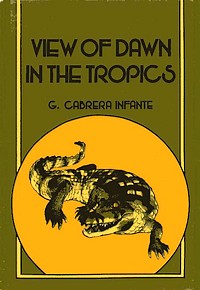
Excerpt
The comandante gave him a story to read. In it a man would go into the bathroom and spend hours locked inside it. The wife worried about what her husband was doing in the bathroom for such a long time. One day she decided to find out. She climbed out the window and walked along the narrow ledge that went around the house. She slid up to the bathroom window and looked in. What she saw stunned her: her husband was sitting on the toilet and had a revolver in his hand with the barrel in his mouth. From time to time he took the barrel of the gun out of his mouth to lick it slowly like a lollipop.
He read the story and gave it back to its author without further comment or perhaps with an offhand comment. What makes the story particularly moving is the fact that its author, the comandante, committed suicide seven years later by shooting himself in the head. So as not to wake his wife, he wrapped the gun in a towel.
Comments
Best known for his masterpiece, Three Trapped Tigers, Cabrera Infante described View of Dawn in the Tropics as “a personal statement of the strategies of history.” This short book, barely 140 pages long, comprises approximately 100 vignettes drawn from the history of Cuba. Cabrera Infante’s approach is similar to Eduardo Galeano’s magnum opus Memory of Fire, but distilled to a piercing intensity.
The theme of virtually all of the vignettes is violence. The violence of the first Spanish masters against the natives, the violence of slave rebellions, the violence of colonial wars, the violence of coups and counter-coups, the violence of Castro’s revolution, and the violence of its repressions. Many of the vignettes end in death.
Violence, Cabrera Infante seems to suggest, is endemic to the presence of humans on the island. Whether repressive or liberating, the violence continues, in contrast to the qualities of the island itself:
And it will always be there. As someone once said, that long, sad, unfortunate island will be there after the last Indian and after the last Spaniard and after the last African and after the last American and after the last of the Cubans, surviving all disasters, eternally washed over by the Gulf Stream: beautiful and green, undying, eternal.
Writing from his chosen exile in London, Cabrera Infante seems to draw some hope from this perspective. If violence is the legacy of humans on Cuba, it’s a legacy that will last only as long as there is human memory. As he writes in one vignette (quoted in entirety): “In what other country of the world is there a province named Matanzas, meaning, ‘Slaughter’?”
